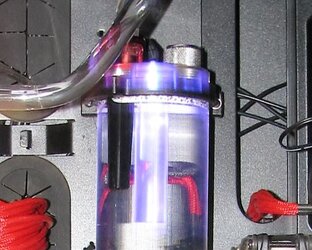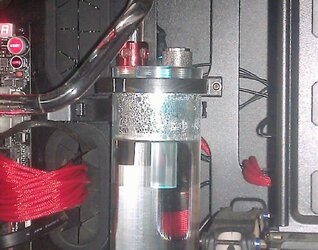I know I read somewhere that there will be some water loss in a loop, even closed loops due to there not being a perfect seal and vapor will be lost over time, or something like that, but what is an acceptable amount? I did a major overhaul of the loop in my sig cause I got a hair... (you get the idea) and decided to put a 3rd gpu in this loop. Well I noticed as the ambient has increased so it's harder to keep my water temps where they were with only two cards, and this has increased the amount of water loss in the system. Now its not much, and if I've done the math correctly (always a fear I have, since I paid so much attention in school) I believe I've lost 0.0848 liters (or 2.8682 ounces) over the past 2 months-ish. This might not sound like much, but here's where the question comes into play, how much water loss is acceptable? Now I might not have lost this much, cause there was undoubtedly some air still trapped in the rads maybe even the blocks that worked it's way out over time, but water loos in a closed system is still inevitable.
This is where it started just about 2 1/2 months ago:

A recent pic, horrible detail, this phone sucks, but you get the gist.

Just food for thought. I mean granted at worst I'm losing 0.00113 liters (or 0.03824 ounces) a day (I find hard to believe) in a loop that hold just under 1 gallon, so theoretically I could run the system for a long time before there was any damage to the components. I mean there is no sign of water leakage, so it's not a leak, but at those numbers even if it were a leak it would probably evaporate before it touched anything important. I would hazard to guess most of the volume drop in my res I noticed was due to air being trapped in the loop and finally making it's way out Since temps have increased here in Texas and thus increased water temps it's a concern that water evaporation is a possibility more than it is in the winter time when it's much easier to keep things cool.
This is where it started just about 2 1/2 months ago:

A recent pic, horrible detail, this phone sucks, but you get the gist.

Just food for thought. I mean granted at worst I'm losing 0.00113 liters (or 0.03824 ounces) a day (I find hard to believe) in a loop that hold just under 1 gallon, so theoretically I could run the system for a long time before there was any damage to the components. I mean there is no sign of water leakage, so it's not a leak, but at those numbers even if it were a leak it would probably evaporate before it touched anything important. I would hazard to guess most of the volume drop in my res I noticed was due to air being trapped in the loop and finally making it's way out Since temps have increased here in Texas and thus increased water temps it's a concern that water evaporation is a possibility more than it is in the winter time when it's much easier to keep things cool.
 )
)